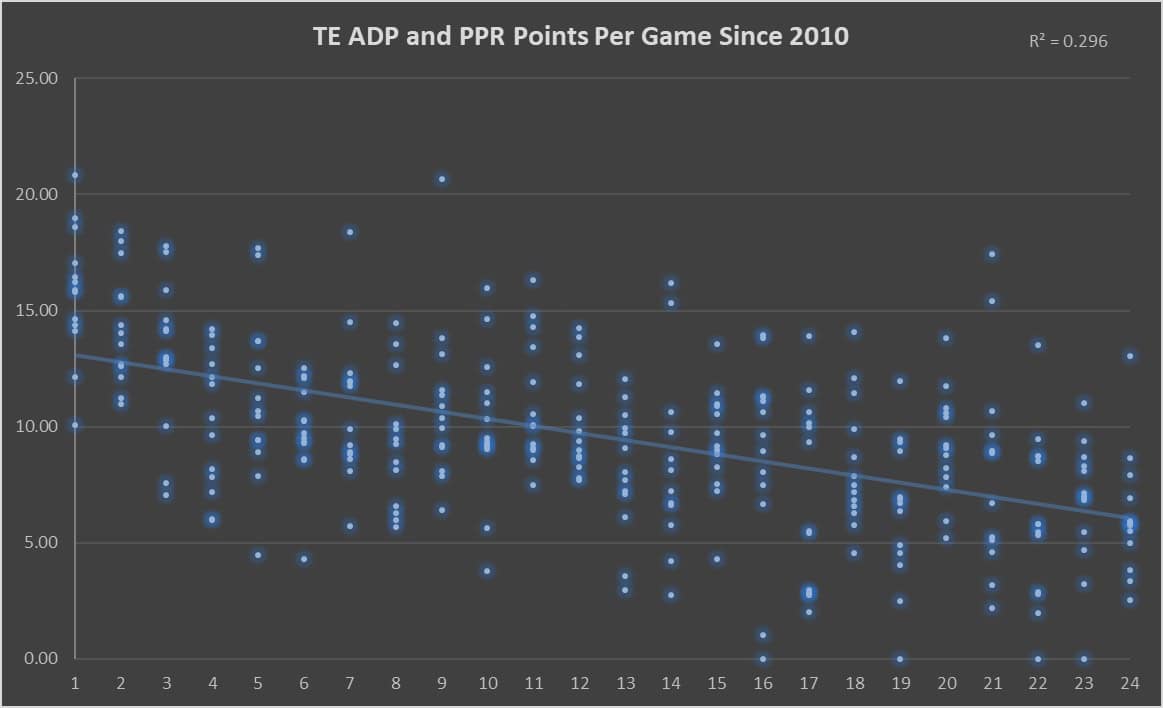- The tight end position holds the weakest correlation between ADP and points per game outside of quarterback for fantasy, but we are getting better at setting the market. The four seasons with the highest correlation to ADP and points per game since 2010 have been over the past four years.
- Sam LaPorta led the position in overall scoring last season while being drafted on average as TE18. That was the first time since I recorded ADP that the tight end with the most points scored was not selected inside of the top 10 at the position.
- Since 2010, 63.9% of all TE1 scorers have been either the first or second pass catcher from their team.
As we prepare for our 2024 fantasy drafts, let's dive into the recent history of average draft positions to pull away any ongoing trends or pitfalls.
We have nearly eight full months to prepare for the draft every year, but how good are we at setting the market for the season?
We are looking to hash that out here, continuing with the tight ends.
Tight End Fantasy Related Articles:
Reaching our final position in the series, the tight end position holds the weakest correlation between ADP and points per game outside of quarterback for fantasy from a top-down stance.
When you combine that with the position scoring the fewest points compared to every other, you can see how frustrating and lopsided this position can be for gamers.
This is why unique elements and caveats are incorporated into scoring for the position in some formats.
I would argue that those are half-baked measures that do not achieve the intended results, but gamers are tweaking scoring for tight ends more than in other skill positions.
Just two tight ends in our sample have averaged over 20 PPR points per game in a season.
One of those (Rob Gronkowski in 2011) was a value pick (TE9 in ADP that season).
The tight end position carries similar traits as the other positions we have covered.
If you have been following this series this week, genuine season-long weekly winners just do not come from the bottom of drafts often.
The tight end position is no different.
Even if we lower our arbitrary high-scoring bucket down to 15 or more points per game (something no tight end accomplished in 2023), 84.6% of the tight ends to achieve that mark were also selected as TE1 (top-12) that offseason.
Even more wild is that 69.2% of those tight ends were selected as top-five picks that offseason with 61.2% chosen in the top three.
Don't miss out on the best fantasy football coverage in the business
Like the NFL, fantasy football never sleeps.
Best ball season is in full swing, and traditional drafts are right around the corner.
Sharp Football has everything you need to prepare for both in our Fantasy Football Draft Kit, powered by premier fantasy football analyst Rich Hribar.
Save more by bundling the Draft Kit with our in-season fantasy package that features Rich's comprehensive “Worksheet” preview of every game, every week of the NFL season.
Click here for more information about our fantasy coverage!
Top-24 TE in ADP & Correlation to PPR Points Per Game Since 2010
| Year | R2 |
|---|---|
| 2023 | 0.5342 |
| 2022 | 0.4352 |
| 2021 | 0.5662 |
| 2020 | 0.4611 |
| 2019 | 0.2061 |
| 2018 | 0.2937 |
| 2017 | 0.2829 |
| 2016 | 0.3013 |
| 2015 | 0.0963 |
| 2014 | 0.0852 |
| 2013 | 0.4326 |
| 2012 | 0.3163 |
| 2011 | 0.2461 |
| 2010 | 0.2865 |
We did the best at setting the market among tight ends last season compared to all of the positions.
With wide receivers being second and far above running backs and quarterbacks, we did our best in drafting pass catchers in 2023.
For tight ends, we have been a strong run at properly setting the market.
The four seasons with the highest correlation between ADP and points per game have come over each of the past four seasons.
Just because we did well does not mean there were no values here, however.
Sam LaPorta led the position in overall scoring last season while being drafted on average as TE18.
That was the first time since I recorded ADP that the tight end with the most points scored was not selected inside of the top 10 at the position.
We also had TE1 scoring campaigns from Trey McBride (TE32) and Jake Ferguson (TE25).
Outside of those breakouts, among the top 14 scoring tight ends, nine of them were selected as TE1 options.
The only TE1 picks that were outright busts were Darren Waller and Pat Freiermuth.
Since 2010, 62.3% of all TE1 scoring seasons have come from players selected as TE1 picks.
If looking at front-end scorers at the position, 72.9% of all players to close the season as a top-six scorer over that span were selected as TE1 picks.
Tight end has largely been a pay-to-play position for elite production.
Outside of LaPorta’s surge last season, the other top-five scorers were Evan Engram (TE8 in ADP), Travis Kelce (TE1), T.J. Hockenson (TE3), George Kittle (TE4), and David Njoku (TE10).
Six of the top seven tight ends in points per game were selected as TE1 picks last season.
With that in mind, this is also where opportunity cost once again pops up since we are also drafting running backs and wide receivers early under the same principles.
The gift and curse of early tight ends that hit is that while they provide strong position leverage, running backs and wide receivers score more points than tight ends.
Kelce led the position in points per game (14.6), which was on par with the TE20 and the RB16.
Running backs and receivers also require much more roster investment to account for starting lineups, injuries, and busts, so that point differential is massive.
Now, Kelce has had stronger seasons than last year, but when you are drafting a tight end with premium draft capital, that player must turn in a scoring season that is comparable with WR1 and RB1 scorers.
That is a thin needle to thread.
This is when you will have to decide if pursuing that front-end tight over a potential elite running back or wide receiver is worth the draft cost or not.
A front-end tight end season is a weekly hammer, but you can also win a league with pedestrian tight end output compared to the impact of getting lackluster output from a running back or a wide receiver.
After that front line at the tight end is when things start to get murky with a massive drop-off.
The tight end position has had a dead zone similar to running backs in the middle rounds of drafts.
Among tight ends selected in the single-digit rounds after the fifth round, those tight ends have produced a TE1 scoring season just 46.1% of the time with a 17.1% rate in the top-six and a 10.5% rate as a top-three scorer.
Every single one of those players was selected as a top-12 player at the position.
It is harder to hit full-season TE1 production from a TE2 or later, but on average 25% of the TE1 field will be selected as a TE2 or later per season, which last season was right on par with.
Draft Top Pass Catchers
One of the things we hammered on in the tiers at tight end is that you want to target a player who is the first or second option in his passing game.
Since 2010, 63.9% of all TE1 scorers have been either the first or second pass catcher from their team.
There have been 55 tight ends selected as the first pass catcher from their team since 2010.
35 of them (63.6%) have ended the season as a TE1 scorer.
This season, Kelce, Mark Andrews, and Dalton Kincaid are the first pass catchers being selected from their passing trees.
Only 19.3% of all tight ends selected after their team’s WR2 have finished the season as a TE1 scorer.
Only 34 of those players were selected as TE1 options, however, so expectations were already low.
But of those 34, only 18 were TE1 scorers and just nine ended the season as a top-six scorer.
Of all of the tight ends to beat their ADP and finish as a top-12 scorer the same season, 62.5% were selected ahead of their team’s WR2.
Only one time (Gronk in 2011) has the TE1 in overall scoring been selected after the first two wide receivers on his team.
Last season, Dallas Goedert, Freiermuth, and Kincaid were TE1 picks who were selected after the first two wideouts on their roster. Only Kincaid matched his ADP.
This season, George Kittle (pending a trade of Brandon Aiyuk) and Goedert are being selected as TE1 picks but after the top two wideouts on their teams are being picked.
Be Wary of Elite WRs
In our sample, there have been 43 tight ends attached to a wide receiver with an ADP in the first round.
Only 10 of those tight ends went on to post a TE1 scoring season.
Just four of those had a top-six scoring campaign.
16 of those 43 were also being selected as TE1 picks.
Less than half of those (seven) ended the year as TE1 scorers and just three as top-six scorers.
The TE1 in overall scoring has never been attached to a Round 1 wide receiver.
LaPorta came the closest last season with Amon-Ra St. Brown holding a higher-end ADP in Round 2.
Just one tight end who has led the position in overall points has been attached to a Round 1 wideout, which was Kelce in 2021.
110 tight ends have been attached to a WR1 being selected in the first two rounds of fantasy drafts.
Just 38 of those (34.5%) ended the year as TE1 scorers.
Only 38 of those picks were also being selected as TE1 options.
Of those 38, just 17 (44.7%) ended the year as TE1 scorers.
While dire numbers overall in turning in a TE1 season attached to a front-end receiver, 16 of those 17 players were picked ahead of the team WR2 that season.
LaPorta and Ferguson are attached to Round 1 wideouts but also are the second pass catchers drafted from their team.
Kyle Pitts and Brock Bowers are attached to Round 2 wideouts but are also second in ADP among their pass catchers.
Goedert is not only attached to a Round 1 wide receiver but also a Round 2 wideout.
Kittle (for now) is attached to a pair of Round 2 wideouts.
You can still be a TE1 scorer and a fine fantasy pick if attached to an elite wide receiver, but the margins are tight in turning in an elite TE1 overall season.
Nothing from LaPorta’s situation has worsened this offseason, but keep in mind that he was the lowest-scoring TE1 overall since 2017.
He did not provide massive positional leverage despite scoring the most points. All of Engram, Kelce, and Hockenson matched at least 90% of the production that LaPorta had.
LaPorta was also the only TE1 overall scorer in PPR formats over the past 30 years to not even be first or second in points per game. Both Kelce and Hockenson scored more points per game than him a year ago.
Bringing things home in bullet points:
- We have been extremely strong at setting the tight end market. The four seasons with the highest correlation to ADP and points per game since 2010 have been over the past four years.
- Like other positions, you have to “pay to play” to have the best odds at elite season-long production.
- If you miss out on that group, you have been better off waiting to take lower-end TE1 and TE2 options instead of the mid-range TEs that follow the expensive tight ends.
- It is harder to hit full-season TE1 production from a TE2 or later, but on average 25% of the TE1 field will be selected as a TE2 or later per season.
- Tight ends attached to expensive lead wide receivers have paid off at an extremely low rate.
- Target tight ends that are the first pass catcher selected from their teams if possible, even though few exist per season that are not expensive.
- At worst, target tight ends who are one of the top two targets in their offense.



















